| In 1928 the young, freelance motorcycle designer Edward Turner proposed an unusual new engine design having four vertical cylinders arranged in a square.
Because the cylinders were vertical the design required two crankshafts. Because the crankshafts were across the frame the design was almost like two parallel twins
coupled back to front on a common crankcase. Prior four cylinder motorcycle engines had been built in a variety of configurations but Turner had decided they were large, inefficient
and perhaps vibrated too much. The two crankshafts were coupled by geared central flywheels so that the two cranks rotated in opposite directions. With the gears
correctly meshed, the crankpins of one shaft were at top and bottom dead centers while the crankpins of the other were at bottom and top. In other words two diagonally opposite
pistons were at TDC, the other two diagonally opposite were at BDC. The counter-rotating cranks combined
with the crankpin arrangement cancelled the gyroscopic effects of the rotating parts resulting in minimal vibration in a very compact unit. |
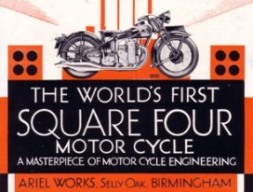
|
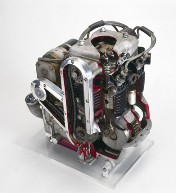
|
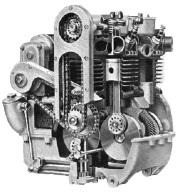
|
| 1930 Motor Cycling Cover | Cutaway OHC Sq4. Note carb
and exhaust ports at front of head. | Diagram showing overhung
crankpins (no outer crank bearings). |
|
| Turner had shown the design to several motorcycle manufacturers (including BSA) seeking a buyer for the innovative design but only Jack Sangster at Ariel was interested enough
to offer the young engineer a job. When Turner joined Ariel he worked with a junior draftsman Bert Hopwood under the authority of Val Page. After 18 months of intense
development the Ariel Square Four was unveiled internally. The result was a 500cc OHC four with enclosed valves and a gear type oil pump - a remarkable departure from the single
cylinder bikes with exposed valves that were common at the time. |

|

|

|
| 1931 4F | Edward Turner with 1931 4F | 1932 600 Square Four |
|
| At its public unveiling at the Olympia Motorcycle Show in late-1930 the 1931 Ariel Square-Four (shown above) caused a huge sensation, even over the new
Matchless Silver Hawk narrow-angle v-four OHC. The Square Four's valves were operated by a single chain-driven camshaft across the top of the head with valves opened by rocker
arms riding on the cam. A distributor was driven off the end of camshaft. A single carb metered fuel and air into an X-shaped intake track, and exhaust ports converged into one exhaust pipe on each side. The first Square Four production models were
500cc touring bikes but the public wanted more power so Ariel increased the capacity to 600cc in 1932 models. 500cc production ended in 1932. |
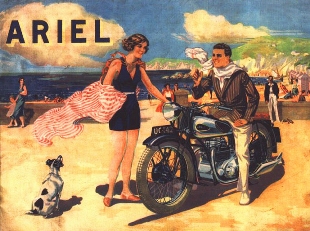
|

|
| Sq4 featured on the 1932 brochure cover. | Seven school boys start the four. |
|
| In 1931 Ariel won the much coveted Maudes Trophy, a test of
durability, reliability, and ease of use. Victor Mole, the sales and marketing manager of Ariel dreamed up the famous Ariel "Sevens" test
involving seven different Ariel models attempting feats related to the number 7. The test for the Square Four involved seven schoolboys each kick-starting
the Square Four 7 times. The Square Four started first kick on 48 of 49 kicks. The Sq4 was then tested to exceed 60mph for 700 miles! |

|
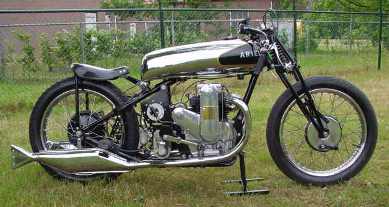
|
| Ben Bickell's supercharged Sq4 with no front brake. | Ted Woodrow's replica of Bickell's Sq4. |
|
In 1933 the speed potential of the Square Four was obvious but unproven until Ben Bickell rode a highly-modified 500 with a supercharger at the Brooklands
track, lapping at over 110 mph and only narrowly missing becoming the first British 500cc to achieve 100 miles in an hour. For a complete history of the Bickell Sq4 and
some history of another supercharged cammy check out this link: http://members.chello.nl/c.knegt7/index.htm Lots of great history and pictures!
The Model 4F Square Fours include all 500cc and 600cc engine displacements and both OHC and OHV layouts. 600cc Sq4s are listed continuously in brochures up through 1937 but only a single picture of the new 1000cc pushrod 4G (more below)
represents both models. The 600cc 4F reappeared 1939 as a pushrod engine and was produced for the '39 and '40 model years. This was essentially a sleeved down version of the newer 1000cc four.
|

|

|
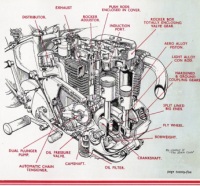
|
| Clarke testing the new 1000cc Sq4. | 1937 brochure showing the new 1000cc Sq4. | 1939 diagram of the Sq4 engine. |
|
| Edward Turner designed the 1000cc 4G pushrod engine to meet a demand for increased power. In doing so he replaced the small diameter geared flywheels with larger diameter overlapping flywheels and separate coupling
gears. This increased the rotating mass to aid in starting from a stop, especially with a sidecar. The greater displacement increased the power to well above that offered by the 500cc Red Hunter and permitted the four to compete
more directly with the large displacement V-twins offered by Matchless and BSA. The design was initially shown in late 1935, but development delayed release until the 1937 model year.
To prove the new design and gain publicity, Edward Turner had Freddie Clarke ride a prototype Square Four 1000cc to Brooklands track and run "ten mph to a hundred in
top". The late '30s British rearmament program was putting people back to work and motorcycle sales skyrocketed. The Square Four was advertised as "The World's Most Wonderful Motorcycle". |
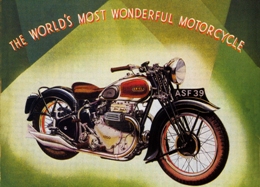
|

|

|
| 1939 advertisement. | 1947 Wispering Wildfire ad. | 1949 4G hanging in a San Francisco Bar. |
|
| In the years after the end of WWII the 1000cc Square Four was advertised as a powerful sporting solo ride. Advertisements proclaimed "Spectacular acceleration", "Rockets from a standstill" and "Whispering Wildfire". In 1949 the cast iron engine was redesigned with an all alloy block and head improving cooling. This reduced weight by 33 lbs with resulting improvements in handling and acceleration.
This all alloy version was later dubbed the 4G Mk I when the redesinged Mk II was phased into production in 1953. Production of the Mk I ended in 1953. |

|

|
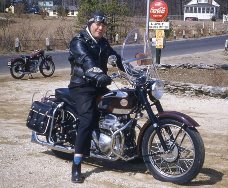
|
| A two-pipe 4G Mk I engine compared with a four-pipe 4G Mk II engine. | A Mk II new in 1953. |
|
| The cylinder head was again redesigned for the 1953 model year, this time with four exhaust pipes to improve cooling. The bike retained the 4G model designation but was dubbed Mk II to distiguish it from the previous twin pipe version.
The four-pipe Mk II entered production in 1953 and was built until the end of Ariel 4 stroke production in 1958. The Mk II retained the plunger-type spring frame first introduced in 1939. A prototype swingarm frame Sq4 was built by Ariel but it
never entered production. The desire to put the 4 cylinder engine into a swing-arm frame has led many owners to install them in modified Ariel or Norton featherbed frames. |
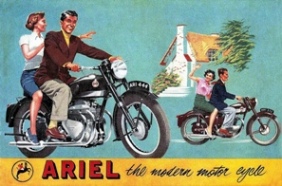
|
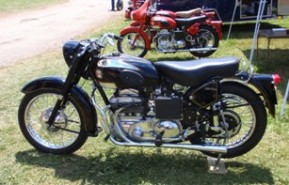
|
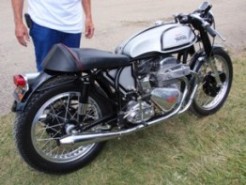
|
| 1954 ad featuring the Mk II. | Bruce's beautiful '59 at Mid-Ohio. | Jerry's Featherbed Sq4 at Mid-Ohio. |
|
| |
Ariel decided to end Square Four production by mid-1959 in part due to the phenomenal success of the innovative Leader and partly due cost cutting within the BSA group (now controlled by Edward Turner).
Ariel produced 15,639 Square Fours from 1931 to 1958. Production numbers for the various engine types are shown in the table at the right. Note that production of 600cc 4Fs includes both OHC and OHV versions. |
 |
|
| |
| Back to Ariel History |